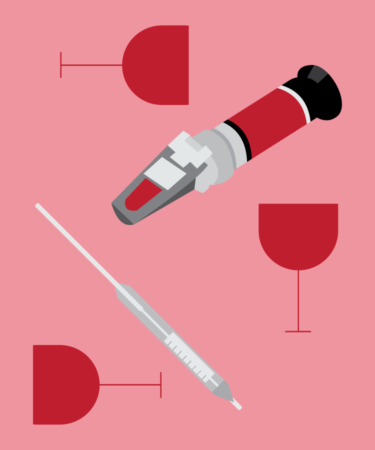As you may recall from high school chemistry class, alcoholic fermentation is the conversion of sugars (like glucose, fructose, and sucrose) into ethanol (alcohol) and carbon dioxide. Or, put simply, without sugar we wouldn’t have booze.
The ability to calculate sugar levels in a liquid, such as grape must or a wort, allows winemakers and brewers to calculate what its alcohol content will be after fermentation. This calculation is an important part of winemaking and brewing, and can affect decisions made in the vineyard, winery, and brewery.
There are a number of ways to measure sugar levels, one of which is by measuring its Brix value.
Don't Miss A Drop
Get the latest in beer, wine, and cocktail culture sent straight to your inbox.What is Brix?
A Brix value, expressed as degrees Brix (°Bx), is the number of grams of sucrose present per 100 grams of liquid. The value is measured on a scale of one to 100 and is used to calculate an approximate potential alcohol content by multiplying by 0.59. So, if a pre-fermented liquid measures 23 °Bx, its potential alcohol content will be approximately 13.6 percent ABV.
The potential alcohol content is only an approximate value because there are other factors in the brewing and winemaking processes that influence fermentation’s efficiency. In reality, the conversion factor of degrees Brix to potential alcohol ABV ranges from 0.55 to 0.65.
How is it measured?
Brix can be measured using two different instruments: A refractometer or a hydrometer.
A refractometer determines degrees Brix by measuring the refraction of light passing through a liquid sample. Liquids containing sugar are denser than water and cause greater refraction as light passes through. The instrument compares this to the refraction of light through water and provides a Brix value.
Refractometers are the preferred tool of winemakers in the vineyard as they offer results from a very small sample size (i.e., the juice from just one crushed grape).
Hydrometers are used before and after fermentation in both winemaking and brewing. They calculate a liquid’s sugar level by measuring its relative density. The instrument utilizes a weighted, floating glass tube that is placed inside a calibrated test tube containing the liquid sample.
The test tube is calibrated to measure the amount of liquid displaced, and from that, determine how much sugar is present.
With both refractometers and hydrometers, adjustments must be made to the calculations depending on the temperature of the sample.
Why do we measure Brix?
Calculating the potential alcoholic strength of a beverage is useful to winemakers and brewers for a number of reasons.
For winemakers, being able to measure the Brix value of grapes in the vineyard helps determine when to begin harvesting. As grapes ripen, their sugar levels increase. The Brix value can therefore be used to identify when the optimum desired ripeness has been reached and show that it’s time to start harvesting.
In the winery, measuring the alcoholic potential of grape must helps winemakers determine whether they need to chaptalize (add sugar) in order to reach the minimum alcohol level defined by the region or appellation’s laws.
Brewers take sample readings before, during, and after fermentation as this allows them to monitor many things, including mash efficiency, whether the brew is hitting recipe targets, the progress of fermentation, and when fermentation has finished.
In practice, brewers prefer to take Plato or specific gravity measurements, rather than Brix, both of which are often also commonly offered by refractometers and hydrometers. But in essence, all three are used to calculate the same thing, potential alcohol content. Should a brewer take a Brix measurement, it can easily be converted to Plato or specific gravity using simple calculations.
